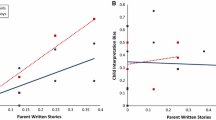Abstract
This study tested the hypothesis that schizophrenics employ more developmentally immature levels of decentering in their structuring of interpersonal relations. A 9-point scale of interpersonal decentering, developed originally by Feffer, was applied to Thematic Appercetion Test stories produced by schizophrenic adolescents and a control group of psychiatrically disturbed patients equivalent in age and intellectual functioning. Results provided convincing support for the hypothesis tested and suggest the theoretical utility of viewing interpersonal deficit in schizophrenia from a cognitive-developmental perspective.
Similar content being viewed by others
References
Arieti, S.Interpretation of schizophrenia. New York: Basic Books, 1974.
Blatt, S. J., & Ritzler, B. A. Thought disorder and boundary disturbances in psychosis.Journal of Consulting and Clinical Psychology, 1974,42, 37–381.
Blatt, S. J., & Wild, C. M.Schizophrenia: A developmental analysis. New York: Academic Press, 1976.
Cameron, N.The psychology of behavior disorders: A biosocial approach. Boston: Houghton Mifflin, 1947.
Chandler, M. J. Egocentrism in normal and pathological childhood development. In F. Monks, W. Hartup, & J. DeWitt (Eds.),Determinants of behavioral development New York: Academic Press, 1972.
Chandler, M. J. Egocentrism and antisocial behavior. The assessment and training of social perspective-taking skills.Developmental Psychology, 1973,9, 326–332.
Chandler, M. J., Greenspan, S., & Barenboim, C. Assessment and training of role-taking and referential communication skills in institutionalized emotionally disturbed children.Developmental Psychology, 1974,10, 546–553.
Feffer, M.Initial story (TAT) scoring categories (American Documentation Institute No. 10032). Washington, D.C.: Library of Congress, 1966.
Feffer, M. Symptom expression as a form of primitive decentering.Psychological Review, 1967,74, 16–28.
Feffer, M. Developmental analysis of interpersonal behavior.Psychological Review, 1970,77, 197–214.
Feffer, M., & Gourevitch, V. Cognitive aspects of role-taking in children.Journal of Personality, 1960,28, 383–396.
Feffer, M., & Suchotliff, L. The decentering implications of social interactions.Journal of Personality and Social Psychology, 1966,4, 415–422.
Feighner, J. P., Robins, E., Guze, S. B., Woodruff, R. A., Winokur, G., & Munoz, R. Diagnostic criteria for use in psychiatric research.Archives of General Psychiatry, 1972,26, 57–63.
Flavell, J.The developmental psychology of Jean Piaget. Princeton: Van Nostrand, 1963.
Garmezy, N. The prediction of performance in schizophrenia. In P. H. Hoch, & J. Zubin (Eds.),Psychopathology of schizophrenia. New York: Grune and Stratton, 1966.
Gelburd, A. S., & Anker, J. M. Humans as reinforcing stimuli in schizophrenic performance.Journal of Abnormal Psychology, 1970,75, 195–198.
Goldstein, M. J., Gould, E., Alkire, A., Rodnick, E. H., & Judd, L. J. Interpersonal themes in the Thematic Apperception Test stories of families of disturbed adolescents.Journal of Nervous and Mental Disease, 1970,150, 354–365.
Grand, S., Freedman, N., & Steingart, I. A study of the representation of objects in schizophrenia.Journal of the American Psychoanalytic Association, 1973,21, 399–434.
Grand, S., Freedman, N., Steingart, I., & Buchwald, C. Communicative behavior in schizophrenia: The relation of adaptive styles to kinetic and linguistic aspects of interview behavior.Journal of Nervous and Mental Disease, 1975,161, 293–306.
Harrow, M., & Quinlan, D. Is disordered thinking unique to schizophrenia?Archives of General Psychiatry, 1977,34, 15–21.
Hollingshead, A. B., & Redlich, T. C.Social class and mental illness. New York: Wiley, 1958.
Lidz, T.The origins and treatment of schizophrenic disorders. New York: Basic Books, 1973.
Looft, W. R. Egocentrism and social interaction across the life span.Psychological Bulletin, 1972,78, 73–92.
Neale, J. M. Egocentrism in institutionalized and non-institutionalized children.Child Development, 1966,37, 97–101.
Plaget, J.The psychology of intelligence. New York: Harcourt, Brace, 1950.
Quinlan, D. M., & Harrow, M. Boundary disturbances in schizophrenia.Journal of Abnormal Psychology, 1974,83, 533–541.
Quinlan, D. M., Harrow, M., Tucker, G., & Carlson, K. Varieties of disordered thinking on the Rorschach: Findings in schizophrenic and nonschizophrenic patients.Journal of Abnormal Psychology, 1972,79, 47–53.
Shimkunas, A. M. Demand for intimate self-disclosure and pathological verbalizations in schizophrenia.Journal of A bnormal Psychology, 1972,80, 197–205.
Silverman, L. H. On the role of laboratory experiments in the development of the clinical theory of psychoanalysis: Data on subliminal activation of aggressive and merging wishes in schizophrenics.International Review of Psycho-Analysis, 1975,2, 43–64.
Suchotliff, L. C. Relation of formal thought disorder to the communication deficit in schizophrenia.Journal of Abnormal Psychology, 1970,76, 250–257.
Sullivan, H. S. The language of schizophrenia. In J. S. Kasanin (Ed.),Language and thought in schizophrenia. New York: Norton, 1944.
Werner, H.The comparative psychology of mental development. New York: International Universities Press, 1957.
Werner, H., & Kaplan, B.Symbol formation: An organismic-developmental approach to language and the expression of though. New York: Wiley, 1963.
Wolfgang, A., Pishkin, V., & Rosenbluh, E. Concept identification of schizophrenics as a function of social interaction, sex, and task complexity.Journal of Abnormal Psychology, 1968,73, 336–342.
Author information
Authors and Affiliations
Rights and permissions
About this article
Cite this article
Strober, M. The structuring of interpersonal relations in schizophrenic adolescents: A decentering analysis of Thematic Apperception Test stories. J Abnorm Child Psychol 7, 309–316 (1979). https://doi.org/10.1007/BF00916540
Revised:
Issue Date:
DOI: https://doi.org/10.1007/BF00916540




